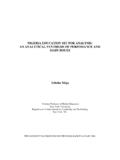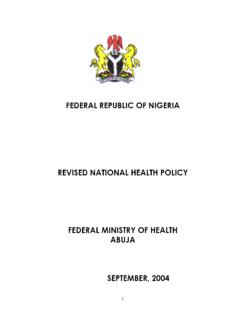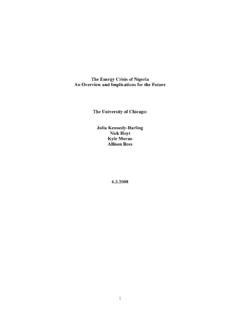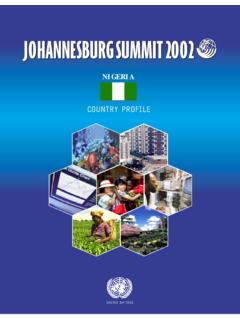Transcription of F2 WHO-AIMS REPORT NIGERIA 23.07.07
1 WHO-AIMS REPORT ON MENTAL health SYSTEM IN NIGERIA MINISTRY OF health NIGERIA 2 WHO-AIMS REPORT ON MENTAL health SYSTEM IN NIGERIA A REPORT of the assessment of the mental health system in NIGERIA using the world health organization - Assessment Instrument for Mental health Systems ( WHO-AIMS ). Ibadan, NIGERIA 2006 Ministry of health NIGERIA WHO, Country office for NIGERIA WHO, Regional Office for Africa, AFRO WHO Department of Mental health and Substance Abuse (MSD) 3 This publication has been produced by the WHO, Country Office for NIGERIA in collaboration with WHO, Regional Office for Africa and WHO Headquarters. At WHO Headquarters this work has been supported by the Evidence and Research Team of the Department of Mental health and Substance Abuse, Cluster of Noncommunicable Diseases and Mental health .
2 For further information and feedback, please contact: 1) Oye Gureje, Department of Psychiatry, University of Ibadan 2) The WHO Representative in NIGERIA 3) Shekhar Saxena, WHO Headquarters, e-mail: world health organization 2006 Suggested citation: WHO-AIMS REPORT on Mental health System in NIGERIA , WHO and Ministry of health , Ibadan, NIGERIA , 2006 4 Acknowledgement The world health organization Assessment Instrument for Mental health Systems ( WHO-AIMS ) was used to collect information on the mental health system of NIGERIA . The project in NIGERIA was implemented by Oye Gureje, Lola Kola and Woye Fadahunsi, Department of Psychiatry, University of Ibadan. This REPORT has been authored by Oye Gureje, Lola Kola and Woye Fadahunsi with assistance from the WHO-AIMS team at WHO, Geneva. The project was supported by The WHO Representative in NIGERIA .
3 The project was also supported by Therese Agossou, WHO Regional Office for Africa.. The world health organization Assessment Instrument for Mental health Systems ( WHO-AIMS ) has been conceptualized and developed by the Mental health Evidence and Research team (MER) of the Department of Mental health and Substance Abuse (MSD), world health organization (WHO), Geneva, in collaboration with colleagues inside and outside of WHO. Please refer to WHO-AIMS (WHO, 2005) for full information on the development of WHO-AIMS at the following website. The project received financial assistance and/or seconded personnel from: The National Institute of Mental health (NIMH) (under the National Institutes of health ) and the Center for Mental health Services (under the Substance Abuse and Mental health Services Administration [SAMHSA]) of the United States; The health Authority of Regione Lombardia, Italy; The Ministry of Public health of Belgium and The Institute of Neurosciences Mental health and Addiction, Canadian Institutes of health Research.
4 The WHO-AIMS team at WHO Headquarters includes: Benedetto Saraceno, Shekhar Saxena, Tom Barrett, Antonio Lora, Mark van Ommeren, Jodi Morris, Annamaria Berrino and Grazia Motturi. Additional assistance has been provided by Erik Goldschmidt. The WHO-AIMS project is coordinated by Shekhar Saxena. 5 Executive Summary Background Information on the mental health service in NIGERIA is lacking. In this REPORT , we have used the world health organization Assessment Instrument for Mental health Systems ( WHO-AIMS ) to collect information on the mental health system in the country. The goal of collecting this information is to provide a comprehensive analysis of the system, focusing on resources in the context of the population they are meant to serve. Essentially, the information contained in this REPORT can provide baseline data required in the identification of specific targets and goals for the development of mental health service in the country.
5 It should also be useful for monitoring progress in implementing reform policies, providing community services, and involving users, families and other stakeholders in mental health promotion, prevention, care and rehabilitation. Even though the results presented here broadly reflect the national picture, their interpretation however requires caution as the survey was conducted in a few selected states of the country rather than on the entire country. The states, representing about 17% of the national population, were selected from the six geopolitical zones in the country. However, the states, on the whole, may be better resourced than most other states in regard to mental health facilities as within them are located six of the eight federally-funded psychiatric hospitals in the country. Results There is considerable neglect of mental health issues in the country.
6 The existing Mental health Policy document in NIGERIA was formulated in was the first policy addressing mental health issues and its components include advocacy, promotion, prevention, treatment and rehabilitation. Since its formulation, no revision has taken place and no formal assessment of how much it has been implemented has been conducted. Though a list of essential medicines exists, they are not always available at the health centers. No desk exists in the ministries at any level for mental health issues 6and only four per cent of government expenditures on health is earmarked for mental health . All of the seven mental health facilities studied are owned by government. In all these facilities, no beds are set aside for children and adolescents.
7 Many of the admissions to community-based inpatient psychiatric units and mental hospitals are involuntary but there are no extant laws to regulate admission policies and protect patients rights. Presently ninety-five percent of psychiatrists in the surveyed areas work only for government administered mental health facilities and five percent work only for NGOs, for profit mental health facilities and private practice. Though physicians are coordinators of the primary care centers located within local government areas, such centers are run by non-physicians. Physicians in PHCs are allowed to prescribe psychotropic medications without restrictions. Non-physicians working at primary care levels can sometimes prescribe but only in situations of emergency. Family and patient associations focusing on mental health issues do not exist in the surveyed areas (and possibly in the entire country).
8 The non-governmental organizations in the surveyed areas are generally not involved in individual assistance activities such as counselling, housing, or support groups. There is no coordinating body to oversee public education and awareness campaigns on mental health and mental disorders. There are no formal structures or provisions for interaction between mental health providers and primary healthcare staff. Also no systematic reporting of information exists for mental health . In general terms, several countries in Africa are better resourced in regard to mental health personnel. Countries such as South Africa, Egypt, and Kenya have more psychiatrists per 100,000 persons and also higher proportions of psychiatric beds. Many countries in Africa also give better official attention to mental health issues.
9 More recent mental health legislations exist in several and mental health issues are specifically addressed by designated senior bureaucrats. 7 WHO-AIMS COUNTRY REPORT FOR NIGERIA INTRODUCTION NIGERIA is a country with an approximate area of 924 thousand square kilometers and a population of million (WHO, 2005). The sex ratio (men per hundred women) is 102 (UNO, 2004). The proportion of the population under the age of 15 years is 44% and the proportion of population above the age of 60 years is 5% (WHO, 2004). The literacy rate is for men and for women (UNESCA/MoH, 2004). The life expectancy at birth is 48 years for males and years for females (WHO, 2004). The health life expectancy at birth is 41 years for males and 42 years for females. The main languages used in NIGERIA are English, Hausa, Yoruba, Igbo, and Pidgin English.
10 The largest ethnic groups are the Hausa and Fulani in the north, Yoruba in the southwest, and Igbo in the southeast. The largest religious groups are Christian and Muslim, and the other religious groups are indigenous groups. The country is a lower income group country based on world Bank 2004 criteria. The proportion of health budget to GDP is The per capita total expenditure on health is US$31, of which US$7 represented government expenditures (WHO, 2004). Information about the level of mental health service in NIGERIA is hard to come by. As will be shown in this REPORT , systematic data gathering and collation are non-existent. It is therefore difficult to identify areas of need, to make informed decisions about policy direction, and to monitor progress. A consequence of this information gap is the continued neglect of mental health issues and the large unmet need for service that exists for mental health problems in the community.














